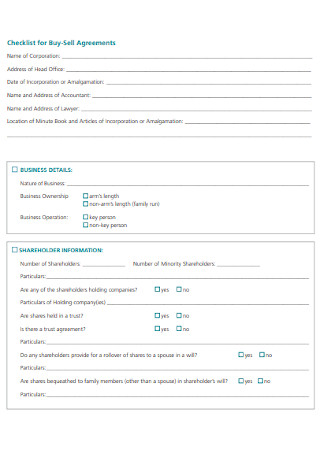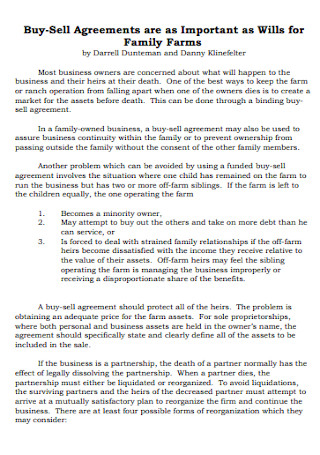22+ Sample Buy-Sell Agreement Templates
-

Sample Buy-Sell Agreement Template
download now -

Buy-Sell Agreements for Wealth Management
download now -

Corporation Buy Sell Agreements
download now -

Cross Purchase Bury Sell Agreement
download now -

Business Buy Sell Agreement
download now -

Simple But Sell Agreement
download now -

Checklist for Buy-Sell Agreements
download now -

Family Farms Buy-Sell Agreement
download now -

One-Way Buy-Sell Agreement
download now -

Life Insurance Fund a Buy-sell Agreement
download now -

Buy Sell Agreement of Business Assets
download now -

Purchase Price for Buy Sell Agreement
download now -

Corporate Buy Sel Agreement
download now -

Understanding Buy-Sell Agreements
download now -

Buy-Sell Provisions in Shareholder Agreement
download now -

Entity Buy Sell Agreement
download now -

Real Estate Buy Sell Agreement
download now -

Stock Buy-Sell Agreements
download now -

Cross Purchase Buy-Sell Agreement
download now -

Simple Buy Sell Agreement
download now -

Buy-Sell Shareholder Agreement
download now -

Lack of Buy-Sell Agreement
download now -

Sample Buy Sell Agreement Example
download now
What is a Buy-Sell Agreement?
A buy-sell agreement is a binding legal document that outlines the agreed terms and conditions of business partners regarding the transfer or reassigns of the partner’s share in business when he or she dies, retires, or exits the business. According to an article from Investopedia, a buy and sell agreement is also called a buy-out agreement, a business will, and business prenup. This type of agreement is mostly used in partnerships and closely-held corporations. A buy and sell agreement is commonly used in an attempt to have a smooth transition in the transfer of ownership from one business owner to another. Having a buy and sell agreement helps business partners manage complex situations and will protect the business and both of their own interests. The agreement may state restrictions for owners to sell their interests to outside investors without approval from both parties. It can also help determine a business’s value. Mainly, the buy-sell agreement serves as the guide for buyouts amongst business owners.
According to the 2019 US Family Business Survey from PwC, 58 percent of family businesses have documented succession plans.
In the data from the US Small Business Administration, 52 percent of business owners are over age 50 and nearing retirement.
Based on the report from Statista, the established business ownership rate in the United States as of 2019 is 10.6 percent.

Why is the Buy-Sell Agreement Necessary for Business?
There are a handful of things that need to be considered in transferring business ownership or selling business shares to existing or new business owners. That is why it is necessary for a business owner to establish a written document that entails ownership terms and conditions. This is where a buy-sell agreement is necessary for business. A buy-sell agreement is essential because it establishes fair value price for shares, sets and develops effective exit strategies, creates a business continuity plan, protects the interests of surviving business owners, and allocates entity control. It is also necessary because it sets out a concrete process of how the transfer of shares or ownership takes place and provides funding and payment methods. Basically, a buy-sell agreement is necessary for business because it gives business owners a clear overview of how the buyout process should be in the intent of minimizing and avoiding potential conflicts in the future.
The Key Elements of a Formal Buy and Sell Agreement
According to an article from Forbes, having a formal buy and sell agreement allows owners to establish desired exit strategies and ownership succession plans. The agreement will also serve as the avenue for business owners to discuss how the process of transferring ownership will work. For business owners to make a formal and accurate buy-sell agreement, they need to know the basic elements that make such an agreement. Here are some of the key elements a buy and sell agreement should have.
Parties Involved.
To make the buy and sell agreement valid, it needs to have information about the parties involved in the business deal. The business agreement should outline detailed information about the seller and the buyer, as well as the business.
Qualifying Events.
What will cause the agreement to effect? This section in the buy and sell agreement should outline the events that will trigger the buy-out. Some events may include death, disability, retirement, divorce, conflicts with co-owners, and more.
Valuation Clause.
Another important element that should be included in a buy and sell agreement is the valuation clause. This information refers to how much your business is worth, and this information should be written accurately and professionally.
Funding Terms.
It is important to make sure that the buyer has the ability to fulfill his or her payment obligations. That is why it is necessary to discuss the funding terms in the buy and sell agreement. The agreement should present funding options, including life insurance policies and installment payments for a specific period.
How to Write a Formal Buy-Sell Agreement
Buy and sell agreements are one of the most important business documents in planning the future of a business, especially small businesses. It is an essential legal form that highlights the rights and responsibilities of each business owner about the continuity of the business. Basically, the agreement is the platform for business partners where they can discuss terms and conditions regarding the company. If appropriately structured, a formal buy and sell contract can address and help avoid problems and issues. If you write one, we have here some tips that you may follow.
Step 1: Look for Sample Buy-Sell Agreement
As much as possible, a buy-sell agreement should be provided the moment the business is formed. In some cases, preparing one can be difficult, especially for those who have no idea how the agreement works. So, looking for a sample buy and sell contract online would be great and convenient. However, a buy and sell contract may differ from what business you are in, so you have to choose the template that will suit your purpose. If you have already chosen one, then you may tailor it to your objective and format it.
Step 2: Indicate the Parties Involved
Once you already have a ready-made buy and sell agreement, the next thing you need to do is to input information that relates to your situation. Start by indicating the parties involved in the contract. The agreement should have full information about the business owners, such as full names, contact information, as well as the name of the company. This section of the buy and sell agreement may read: “The agreement is made as of the 5th day of June 2020 by and between (the owners) Jane Doe, James Smith, and (the corporation) NBV Company.” This statement should be in the opening paragraph of the agreement. You may also include the ownership percentage each business owner holds. Having this information in the buy and sell agreement makes it more formal and valid.
Step 3: Identify Triggering Events
After that, it is time to identify the triggering events that will make the buy-out happen. In this case, you have to discuss with business partners and make a decision of what to include. The most common triggering events that business partners focus more are death and disability. However, it is also important to think beyond those events. Business owners should also consider bankruptcy, loss of professional license, divorce, termination of employment contract, etc. It would be great to consider more triggering events rather than not because it would assure all business partners that there will be no conflict and financial uncertainty when something occurs that is not included in the agreement.
Step 4: State the Business Value and Buy-out Terms
The next thing you need to include in the agreement is the value of the business and the buy-out terms. Deciding this should be well-discussed with other business partners, and everyone should agree to it. There are different ways on how to determine the value of the business, and you have to state in the buy and sell agreement what will be used. You may use agreed value, book value, or appraised value. Either way, every shareholder should agree on what approach to use. On the other hand, the buy-out terms should be concisely written to have a successful and efficient ownership transfer. Nonetheless, the needs and goals of owners must be taken into great consideration.
Step 5: Provide Payment Terms
When you finish with the buy-out terms, it is time to provide information about how to fund the purchase and how long you will pay the departing owner. There are multiple funding mechanisms that you may use, but you have to discuss it with your financial planner or accountant in choosing one. The most common ones are insurance, loans, and installment sales. When it comes to the payment terms, discuss in the buy and sale agreement, how to pay the withdrawing owner, whether through cash or monthly installments. It is also essential for the buy-sell contract to have a payment agreement. The payment terms in the agreement should be well-defined to ensure that both parties are financially protected.
Step 6: Include Termination Grounds
Lastly, specify how to amend or terminate the buy and sell agreement. Deciding on what grounds that will result in a breach of contract should be discussed within the parties involved, and everyone must agree to it. The agreement should also specify the process to undergo. Once that is done, you may now finalize the buy and sell agreement. After that, present the draft to a professional business lawyer so they can help you evaluate the overall contract. If there is no need to revise the buy and sell agreement, then it is time to have it signed. Signing the contract means that everyone has read and understood the contract. Then, provide a copy of the agreement to every individual owner.
FAQs
Is a buy and sell agreement legally binding?
Yes, a buy and sell agreement is a legally binding agreement that presents terms and conditions on how a business partner’s share may be reassigned if he or she dies or departs the business.
When do I need a buy and sell agreement?
Having a buy and sell agreement should be as early as possible. Some may even prepare a buy and sell agreement the moment the business is established. A buy and sell agreement is necessary because it makes the business transfer smooth without any conflicts. It also protects the interests of each business owner when a business partner wants to leave the business.
What are the three types of a buy and sell agreement?
A buy and sell agreement is a written document that stipulates the agreement between co-owners about sharing their shares to their partners when a triggering event occurred. The buy and sell agreement has three types that you may use within your business, which are cross-purchase agreement, redemption agreement, and hybrid agreement.
Thinking about how to hand over your stake in the business when you depart should be one of the many things that need to be considered in business planning. The process of transferring business ownership should be well-planned and well-defined to ensure that there will be no issues to arise. That is why business owners should consider having a buy and sell partnership agreement. This business agreement is an excellent continuity tool that stipulates how a departing business owner will sell his or her shares in the business to existing or new business partners. There are a lot of business planning tools that you may use, and one of the most important and useful ones is the buy-sell agreement.